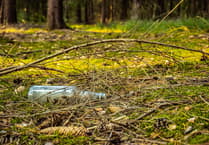If the myriad creatures sheltering in our gardens right now could send us a message they’d be saying, ‘leave us alone until spring!’ We gardeners have been programmed to think that our gardens should be neat and tidy at all times of year. On a mild February day the desire to get into the garden and clear up may be a strong one.
Yet the best thing we can do is leave all those fallen leaves and dead stems where they are until spring proper. The dead leaves that have gathered in corners of the garden may be giving essential shelter to all sorts of creatures against the winter cold.
On going to clear up an accumulation of leaves against the house wall one March I had a shock when a curious round ball underneath it turned out to be a hibernating hedgehog. Luckily I hadn’t disturbed the prickly ball and could hastily rewrap it under its leafy duvet. A couple of weeks later an unexpected cough from that direction told me the hedgehog was waking up. That, if nothing else, reminded me of the importance of waiting to let wildlife come out of shelter at its own pace.
Smaller sheltering creatures may be harder to spot, though one can easily encounter a ladybird nestling in a box bush or a spider’s nest in a wall crevice. Every sighting is a reminder that there are many, many more mini beasts you’ll never notice.
There’s no reason why our gardens can’t both be wildlife friendly and attractive; if you don’t like the fallen leaves on your lawn in autumn then why not rake them onto the borders as a mulch between plants or tuck them under the hedge? There they can provide shelter for overwintering in-sects, maybe in larval or chrysalis forms. The dead leaves will become food for worms who will gradually incorporate them into the soil, thus improving the nourishment available to your plants. They will also help insulate the soil, reducing the amount of cold reaching plant roots. Even better, if you choose not to clear the leaves off the borders in spring they continue to act as a valuable mulch, keeping moisture in the soil and protecting its structure during heavy rains. Resisting the temptation to be too tidy brings many benefits as the weather becomes more extreme – and saves us work.
Another engrained tidying-up habit is to cut down all those dead stems that can be a depressing sight in a winter border. The trick is to leave the ones with seed heads; you may see a flock of goldfinches descend on your garden to feed on them, a joy to behold. And you only have to witness a hoar frost to see how beautiful some of those stems left standing can be when they become ice sculptures.
Instead of clearing early, why not go round your garden and think about where you can create more shelter opportunities for wildlife. Crannies in piles of logs or stones, heaps of dried stems piled out of sight under shrubs or tied in bundles and hung in a sheltered place, all provide essential winter shelter. Or go further perhaps, seeing where you could put up bird and bat boxes or insect hotels. Perhaps there’s room behind the shed for a ‘dead hedge' of garden trimmings or even a compost heap which can harbour all manner of life.
Come the spring, all those creatures coming out of shelter in their own good time will be saying a big thank you.
The Ross branch is planning some Wild About Gardening workshops looking at how you can bring more wildlife into your garden. The first is on Saturday 23rd March 2023, 9.00am - 12.30pm in the Ross Baptist Church.





Comments
This article has no comments yet. Be the first to leave a comment.